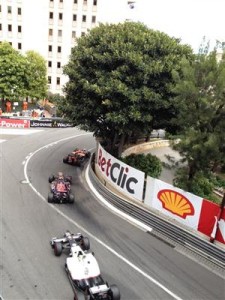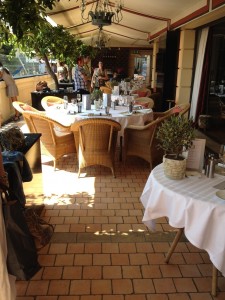Monaco, overlooking the Mediterranean, is home to the most famous car race in the world, a gathering spot for the beautiful and glamorous, a tax haven, and site of one of the world’s most high end non-grand slam tennis tournaments in the world. I have been to Monaco three times, once as I child when I traveled in Europe with my parents, and twice as an adult — in 2012 to attend the Formula 1 Grand Prix of Monaco, and in 2014 to attend the Rolex Masters Monte-Carlo tennis tournament. Both trips made a lasting impression on me.
I was inspired today to write and reminisce about Monaco, since this weekend is the finals of the 2016 tennis tournament, and in a little over a month, they will be holding the 2016 Formula 1 race. If you are a race car fan, a car aficionado, or a tennis fan, these two events are at the top of many bucket lists, particularly, the Grand Prix, like they were for me.
Monaco is a surreal place, with staggering beauty, and wealth, all compacted into a tiny area. After turning 50, the death of my long-time girlfriend 4 year’s earlier, having accomplished my goal of losing more than half my weight (and getting down to what I weighed running the NYC Marathon during law school), I approached 2012 as my crazy fun year, which included buying a new car, driving it in Europe, attending the Grand Prix of Monaco, driving on the Nurburgring, attending the first night of Oktoberfest, seeing the Ryder Cup, and attending the French Open, among other things. My main trip would be in May 2012, take two weeks, including stops in Munich, Lugano, Monaco, Paris (for the French Open after the F1 race), Reims (visiting the Tattinger winery), Strasbourg, and back to Munich. The planning for that trip took over 1 1/2 years, and ended up costing close to $30,000, even with my use of frequent flier miles, hotel rewards, and even getting a free car from BMW for two weeks. Also, should you want to reserve a hotel room for race weekend, be advised you will have to make your reservation over a year in advance, pay in full in advance, and expect a minimum stay of 3 or 4 days. It was a trip of lifetime, and worth every penny.
I will likely speak more about the rest of this trip in another blog entry, but the focus of today’s blog is Monaco. So in May 2012, I drove to Monaco from Lugano, driving down the French coast above the towns and villages, and through one mountain tunnel after another. When I arrived at the Monaco exit, the roadway snakes down to the Mediterranean Ocean. The roads are very tight, with a 30 kph speed limit, and the most prevalent vehicles are scooters and motorcycles. I was driving a BMW 650i coupe, on loan from BMW, and with regard to the whole car hierarchy for that weekend, mid-level in the pecking order at best.
I was staying at the Hotel Metropole, one of three 5-Star Hotels in Monaco which are right by the race course — Hotel Metropole with its view from Casino Square to Mirabeau corner, Hotel De Paris with its view of Casino Square, and the Hotel Hermitage, with its view of the harbor and the race track below. Of the these hotels, I think the best one to watch the race from is the Hotel Metrople, as it is right next to the track and the viewing area is (i) just a floor up from the track (the Hermitage is not right next to the track, but up on a hill overlooking the track), (ii) has a wide scope of view from just after Casino Square to Mirabeau corner (whereas, the view from the Hotel De Paris is just of Casino Square), and (iii) there is a lot a action at Mirabeau corner. The place to watch the race at the Hotel Metrople, is the 2 Michelin Star Joël Robuchon restaurant, which has an outdoor terrace where you can watch race, and has TV monitors so you can see the rest of the race (see above pictures of the terrace and of Mirabeau corner). But you must make your reservations at least a year in advance, and bring your American Express Black Card, since watching the race on Sunday while having lunch, was the most expensive individual meal I have ever had, over $1,500/person without alcohol (plus you most be a hotel guest), but it was a lifetime experience, and completely worth it.
The race schedule is that there are practice sessions on Thursday, nothing on Friday so the race course is accessible to normal traffic, more practice and qualifying on Saturday, and the race on Sunday. I arrived on Thursday, and was able to have lunch and watch a practice session. As I was driving down towards the Metropole, on the Avenue de la Madone, there were all sorts of outdoor kiosks on my right hawking Formula 1 stuff, the Metropole Shopping Center to my left, and a tight left hand turn onto the main driveway of the Metropole. In my 650i I needed help to navigate the tight entrance, and it took a few tries to turn without hitting anything. A few interesting notes — the bottom portion of the Avenue de la Madone ends at Avenue des Spelugues (which is the race course), but the intersection creates a bump in the course that the drivers must swerve around, and off to the right of Mirabeau corner there is a run off area in case someone overcooks the turn, with a crane stationed there to hoist the cars right off the course if they miss the turn and cannot turn around.
At the restaurant you are given ear plugs since the sound is amazing and loud. I also brought my iPad (with an F1 app), so I could see in real-time where all the race cars were located on the track, get race information, and communicate with friends and family via e-mail as the race was going on, and they were watching on TV from the US. That was so cool, and I felt so connected — watching the race live in front of me, watching the rest of the race on the TV’s in the restaurant, tracking the race with my iPad, and communicating with family and friends as it was happening.
Before the race starts on Sunday, there is another race, and then the race car drivers are put on a flat-bed trailer, and driven around the course waving to the the spectators, with Prince Albert driving in front of the truck (yes, he was actually driving, with his with in the passenger seat) in a purpose built Lexus without a roof, so he could also wave to the crowd. You would think he would be driving some other car beside a Lexus, but I am sure much money was involved in that promotion. Also, although he is your royal highness Price Albert, he looks more like an Al from Queens.
As I mentioned, there is no racing on Friday, so I took the opportunity to play tennis at the Monte Carlo Country Club (“MCCC”) with one of the pros at the club. I have been to many tennis and country clubs in my lifetime, but have never played tennis on more picturesque tennis courts. On one side is a cliff, and you can periodically see hang gliders taking off and flying. On other side, you look upon the Mediterranean, with the courts placed in a terraced configuration. Their idea of an indoor court is an angled tarp that covers a few courts. The above picture of me in tennis gear was taken from the MCCC in 2012, and you can see in the background, some of the yachts for race weekend — the other picture, in a white shirt, jeans and sunglasses was take in April 2014 during the tennis tournament. I fell in love with the place, and vowed to return for the ATP tennis tournament they hold at the MCCC every year, which I did in 2014.
At the tournament, there is a open air restaurant overlooking the main show court, and during play, you can hear wine glasses clinking, silverware clanking, and people speaking, and it also takes the crowd longer than usual to get settled during changeovers. When you appreciate that many spectators at this tournament make much more money than the top pros, and are used to getting their way, you can then understand why they do not care to be quiet or well behaved, since for them, this is their social gather not a tennis tournament BTW — there is also another private dining area behind the courts on a patio (difficult to get access to), and this is where I ate since the main court restaurant required real local connections to get a table, which I did not have.
The MCCC is within walking distance from the Metropole Hotel, and I would walk back and forth every day. You can follow different roads, but I preferred to walk along the road by the ocean, which also had a boardwalk. By walking Monaco, you really get a sense how how dramatically the elevation changes, and this is also true of the race course. On TV, you never get a sense how dramatic the changes in elevations are throughout the course.
So what are some of my impressions and observations about Monaco? First, the primary pastime in Monaco is “peacocking”, so it is about who has the most exotic and rare car, the longest yacht, the most expensive watch (with the most complications), the most stylish outfits and shoes, etc. — you get the idea. Some of the yacht are so big they cannot fit in the harbor, and the yachts in the harbor are by no means small. Also, the cars parked around the Casino, are the most amazing cars you will ever see, and there is a real pecking order about how the cars are parked by the various valets — Ferrari, Lamborghini, Bugatti, Rolls Royce, Porsche, etc. Also, through the day and into the night, you can hear people revving their engines — it is not because they are driving fast, as the roads are tight and crowded, it is just they revving their engines to sound cool. They also drive around the race course route, and people stake out prime corners to take pictures of these cars. It is also interesting the the official Ferrari dealership does not have Ferrari in its name, but is call Scuderia Monte Carlo (“Scuderia” means stable or team in Italian), as if every one should know that the only Scuderia that matters is Ferrari.
Speaking of Ferrari, at the 2014 tennis tournament I spoke to fellow American who had moved to Monaco. The first thing he bought when me moved to Monaco, was two Ferrari’s, but he cannot drive them fast in Monaco, and if he drives to nearby Nice, France, he is worried the car will be stolen. Talk about golden handcuffs.
Well, I could write even more about Monaco, like how the Casino is flooded with scantly clad women, or how even in Monaco, you can find a supermarket, but there has to be some end to this blog entry. For another day.












